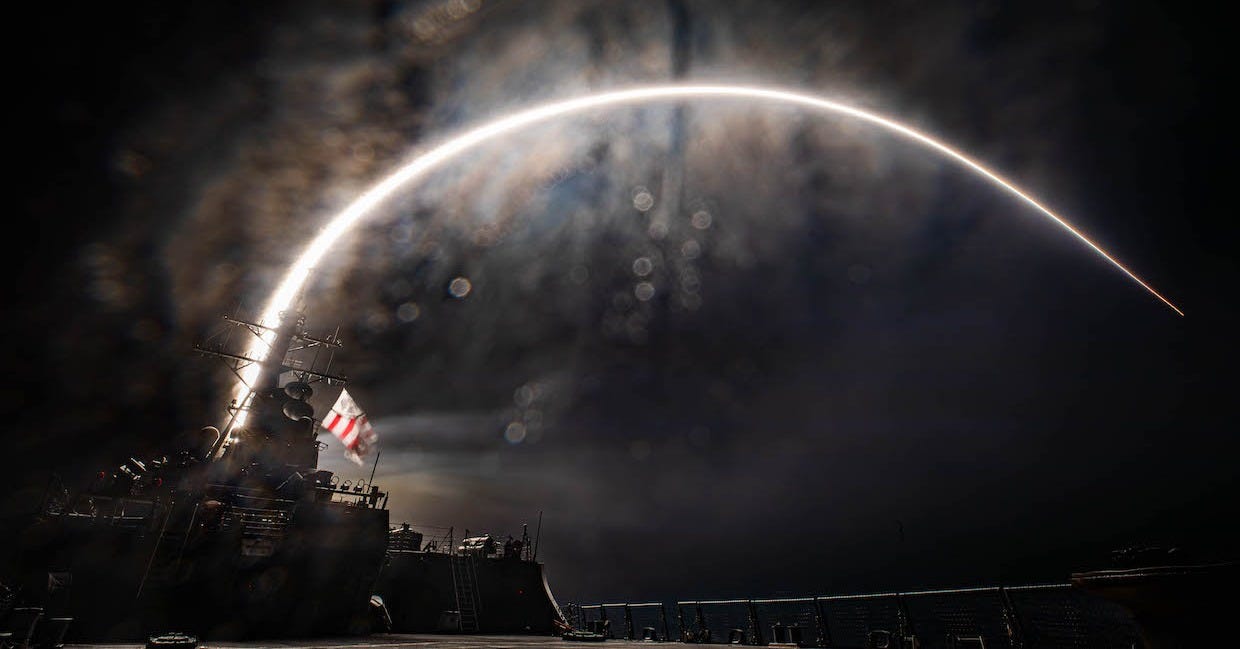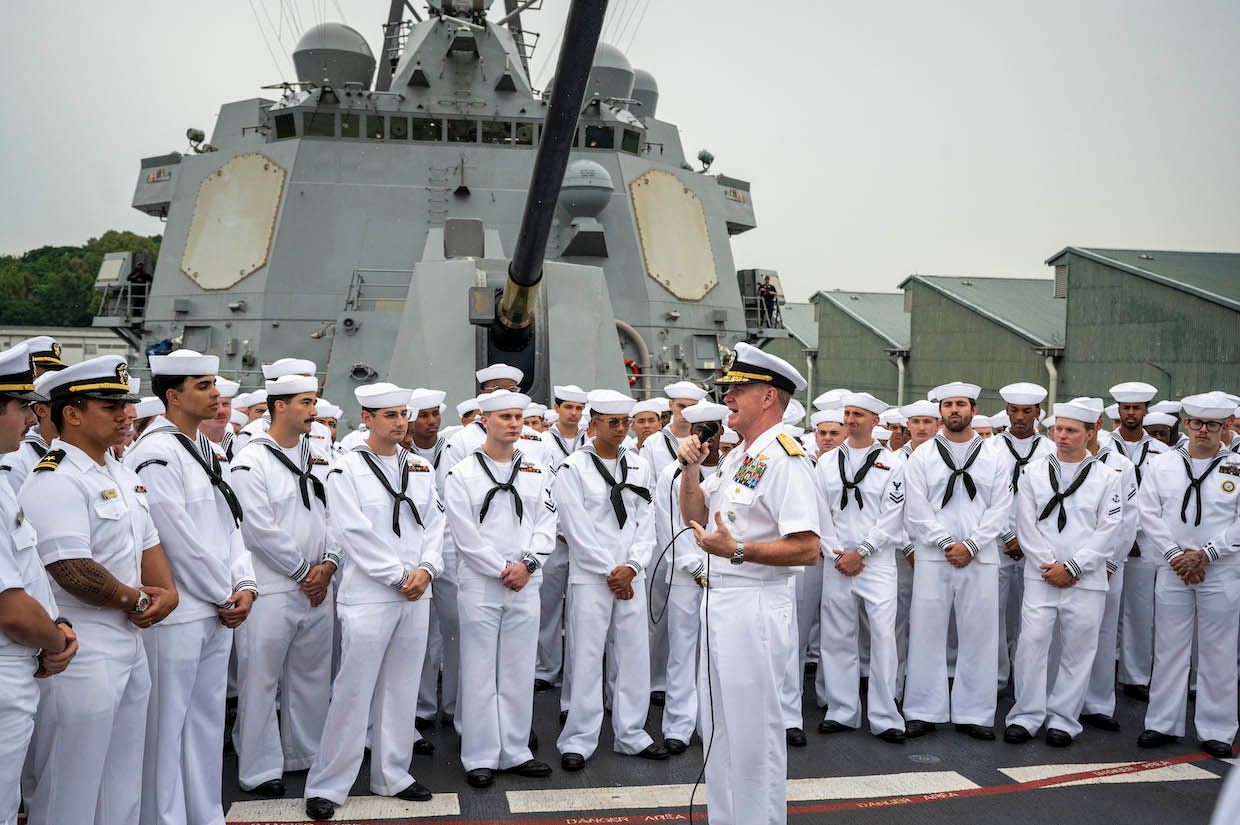Taking stock in America's priority theater
The US's ongoing combat operations in the Middle East have raised doubts that enough resources would be available for a conflict in the Pacific.

The US military has rushed forces to the Middle East this month to help defend Israel after it attacked Iran.
The US has been helping defend Israel from Iranian-backed missile and drone attacks since late 2023.
That has raised concerns about US military resources available for the Pacific, which officials call the “priority theater.”
After Israeli forces launched an intense and wide-ranging attack against Iran early on June 13, the US military is again deploying warships, aircraft, and air-defense systems to the region to help Israel thwart missile and drone attacks from Iran.
The US response comes after a year and a half of similar support, and the munitions expenditures over that time drive concerns that the US is depleting stocks of high-end missiles and other weapons that would be needed in large numbers in a conflict with China.
The Trump administration has not yet joined Israel’s attack, which upended US talks with Iran about a revived nuclear deal, but its extensive support and confrontational approach to the crisis contrasts with Trump’s stated aversion to getting entangled in foreign wars. It will also deepen skepticism that Washington will follow through on its longstanding pledge to direct more resources and attention to Asia — an ambition that Defense Secretary Pete Hegseth underscored in a recent speech in the region.
“This will probably kill any chance of a US-Iran deal, get US service members killed, and delay a US pivot to China,” Emma Ashford, a senior fellow at the Stimson Center and an expert on US foreign policy, said shortly after the Israeli attack began. “They must be breaking out the champagne in Beijing.”
'Eating into stocks’

Since Hamas attacked Israel in October 2023, the US military has had an increased presence in the Middle East. About 40,000 troops are there now, compared to about 30,000 normally. By the time Iran launched its first retaliatory strike on June 13, US forces in the region had been put on alert and several warships were headed there to help with air defense. US missile-defense systems, including Patriot batteries in the region and a Terminal High Altitude Area Defense system in Israel, helped counter that Iranian strike. Navy destroyers have also helped intercept Iranian missiles.
More US forces are on the move. Dozens of tanker aircraft, which could refuel US or Israeli jets, have been tracked deploying to bases in Europe in recent days. The USS Nimitz carrier strike group is also on its way to the Middle East. The Nimitz was operating in the Pacific and was to replace the USS Carl Vinson strike group in the Middle East at a later date, but it was apparently ordered to leave early and join the Carl Vinson.
US efforts to shoot down missiles and drones launched by Iran and Houthi rebels in Yemen since late 2023 have been resource-intensive. In mid-April 2024, the Navy’s top civilian official said the service had employed nearly $1 billion worth of munitions — at times using SM-2 and SM-6 missiles that cost $2 million to $4 million each and SM-3s that can cost between $10 million and $27 million. By October, more than $1.8 billion worth of interceptors, including more than 100 SM variants, had been used. Use of those missiles and of Patriot and THAAD interceptors, which cost several million dollars each, drained US stocks to the point that officials began conserving them, looking for alternatives, and urging industry to increase production.
Those expenditures have added to questions about military readiness for a potential conflict with China, which have persisted since the US started sending arms to aid Ukraine against Russia in early 2022. US defense firms have increased production of some weapons, like artillery shells, but have struggled to churn out higher-end hardware, like guided missiles. Officials and experts have argued that the weapons needed in the Pacific, a mostly air and naval theater, were distinct from what was being sent to a land war in Europe, but the demands of nearly two years of combat around the Middle East have been felt across US stockpiles.
Asked at an event in November 2024 if wars in Europe and the Middle East had an impact on readiness in the Pacific, Adm. Samuel Paparo, the head of US Indo-Pacific Command, said, “Up to this year, where most of the employment of weapons were really artillery pieces and short-range weapons, I had said not at all.”
“But now, with some of the Patriots that have [been] employed, some of the air-to-air missiles that have been employed, it's now eating into stocks, and to say otherwise would be dishonest,” Paparo added.
Since then, the intensity of combat has varied but the expenditures have continued. The Trump administration stepped up strikes on the Houthis with Operation Rough Rider in mid-March. By early May, the operation had cost more than $1 billion, with hundreds of 2,000-pound bombs and dozens of Tomahawk and AGM-158 cruise missiles, which both cost over a million dollars apiece, used in airstrikes. (The US and the Houthis agreed on a ceasefire, ending the operation, on May 6.)
In addition to wear and tear from combat and extended deployments by warships, fighter jets, and bombers, other costs have mounted. More Patriot batteries have been sent to the region — Paparo told lawmakers in April that it took 73 flights by C-17s, a cargo plane that costs $27,000 an hour to operate, to move a Patriot battalion from South Korea to the Middle East. In the first few months of 2025, three F/A-18 jets, each worth $67 million, were lost in accidents on the USS Harry S. Truman, and Houthis have downed more than a dozen Reaper drones, which cost about $30 million each.
US military stocks are “fungible” and can be directed to any region, Paparo said at the event in November, but using them elsewhere “imposes costs on the readiness” of the military in the Indo-Pacific, “which is the most stressing theater for the quantity and quality of munitions, because the [People’s Republic of China] is the most capable potential adversary in the world.”
“We should replenish those stocks and then some. I was already dissatisfied with the magazine depth. I'm a little more dissatisfied with the magazine depth,” Paparo added. “It's a time for straight talk.”
‘Costly diversions’
The profligacy of US military operations in the Middle East and their impact on supplies available to other commands, especially Indo-Pacific Command, has become the subject of jokes online, but recent reports suggest military leadership in the region is mostly getting its way in Washington.
Gen. Michael Kurilla, the head of US Central Command, which is responsible for the Middle East, has reportedly wielded outsize influence over decision-making, thanks to his force of personality, support and deference from Hegseth and Trump, and the vacuum left by the marginalization of the State Department. Central Command “is trying to grab every asset they can from every other theater,” a person described as “familiar with the dynamic” between Kurilla and other Pentagon officials told Politico.
US moves suggest Kurilla and others favoring strong action in the Middle East have so far won out over those advocating restraint or calling for prioritization of China, a camp that appears weakened after recent departures from the Pentagon. What impact that could have on the administration’s approach to Asia remains uncertain, but partners in that region who have watched Trump question US security commitments there and are worried about Washington’s reliability likely noticed that the USS Nimitz’s sudden departure for the Middle East caused the cancelation of a port call in Vietnam, a country the US has worked hard to improve relations with in recent years.
Hegseth tried to address those concerns in late May, when he made his second trip to the region and addressed defense officials and experts at the Shangri-La Dialogue. He offered assurances while emphasizing the Trump administration’s desire for them to do more.
“As our allies share the burden, we can increase our focus on the Indo-Pacific, our priority theater,” Hegseth said. “For a generation, the US ignored this region. We became distracted by open-ended wars, regime change, and nation-building. I had a front-row seat as a soldier in Iraq, in Afghanistan. These costly diversions lacked clearly defined goals and were not tied to vital and core American interests. President Trump is changing that.”




